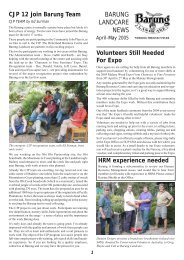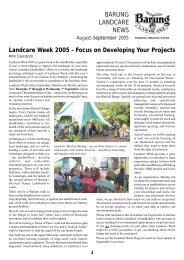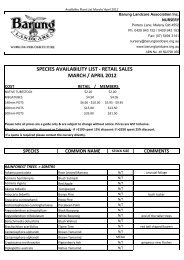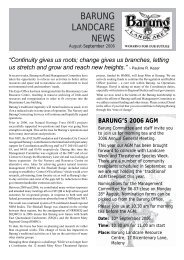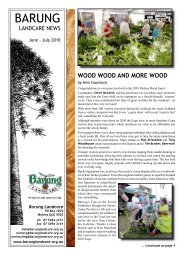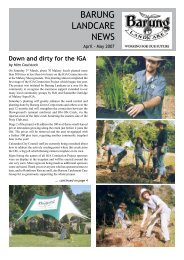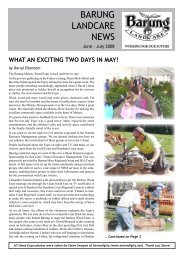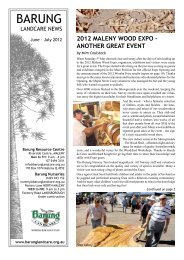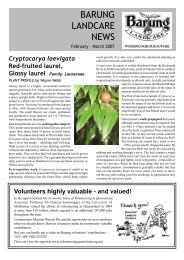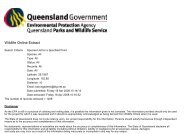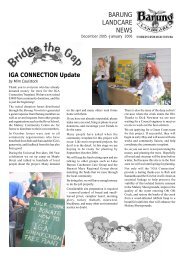Jun/July 2005 - Barung Landcare
Jun/July 2005 - Barung Landcare
Jun/July 2005 - Barung Landcare
- No tags were found...
You also want an ePaper? Increase the reach of your titles
YUMPU automatically turns print PDFs into web optimized ePapers that Google loves.
Sustainable agriculture and food systems<br />
SUSTAINABLE SOLUTIONS<br />
by Jackie Montgomery<br />
The world’s first human inhabitants lived sustainably with nature.<br />
They hunted and gathered to feed themselves and engaged in social<br />
systems that ensured they did not take more from the environment<br />
than could be replenished. As human populations have expanded,<br />
hunter-gatherer societies have all but disappeared.<br />
Agriculture has taken over as a method for feeding the growing<br />
human population. It has enabled people to settle, store food and<br />
participate in a cash economy. People no longer have to produce<br />
their own food and they are freed to undertake other careers. In<br />
the western world most of us rely on others to grow and<br />
manufacture our food.<br />
Agriculture has changed our natural environment. When first<br />
colonising Australia, farmers and the government were unaware<br />
that their practices could be so damaging. Natural resource<br />
management is now a very important issue in sustainable<br />
production – to degrade the environment means we also degrade<br />
our resource base for production.<br />
We learn by past mistakes and continue to expand our knowledge<br />
toward better land management practices. Farmers, researchers,<br />
government departments and environmental groups are working<br />
together to improve the quality of the land.<br />
In spite of this work, most of our food is not the wholesome food<br />
our parents or grandparents would have eaten. Nutrients are lost<br />
Great Balls of Fireweed<br />
WEEDS by Greg Brown, Caloundra City Council<br />
What can out-compete kikuyu pastures, can kill grazing animals,<br />
grows as a small bushy herb with yellow daisy-like flowers (about<br />
the size of a five-cent coin) which produce thousands of windborne<br />
seeds, and has already been found in the Maleny district<br />
The answer is fireweed (Senecio madagascariensis). The name<br />
‘fireweed’ is in recognition of its ability spread across the<br />
landscape like a ‘wild fire’. This Class 2 Declared Pest Plant is a<br />
winter flowerer, so landholders should be vigilant for any suspect<br />
looking plants around the area from now until about November.<br />
Introduced from Madagascar, fireweed was first recorded in the<br />
Hunter Valley in 1918 – possibly as a garden escapee. Over the<br />
last couple of decades it has spread rampantly along the east coast<br />
of Australia, and it is now established as a major problem from<br />
south of the Brisbane River to the Victorian border.<br />
The weed contains poisonous alkaloids that damage the liver of<br />
grazing animals. Symptoms of poisoning include aimless<br />
wandering, loss of coordination, sensitivity to sunlight, jaundice<br />
and abdominal straining. Severe poisoning can lead to death. The<br />
alkaloids can also taint the milk of both dairy cows and goats.<br />
A number of fireweed infestations have been reported in this<br />
district over the last five or so years. But a combination of early<br />
detection and rapid action has meant they have been contained<br />
and controlled. The key to success so far is EARLY DETECTION.<br />
This is where you (the landholder) comes in. The more eyes that<br />
know what to look for, the more chance we have of catching any<br />
new infestations before they become big infestations.<br />
Seeds will mostly be brought in as a contamination of something.<br />
That may be fodder sourced from south of the Brisbane River,<br />
turf imported from NSW, horses or 4WD vehicles used in areas<br />
from Logan south into NSW and not washed down before<br />
13<br />
when the food is grown using artificially manufactured chemicals.<br />
Nutrients are often lost as manufacturers speed up the processes<br />
of food making. Salt and sugars are added to make the highly<br />
processed foods more palatable.<br />
Today we have perfect-looking food with little natural flavour or<br />
aroma often low in dietary value.<br />
Around the world consumers are voting with their actions and<br />
money. They are demanding more environmentally friendly and<br />
healthy foods. They are buying organic foods free of chemical<br />
residues, local foods, free-range poultry and eggs and fair trade<br />
goods. Consumers are saying no to GM foods and demanding to<br />
know what is being added and taken away from our foods in<br />
processing.<br />
They are even changing where they are buying their produce –<br />
they are buying from farmers’ markets, co-operatives, and through<br />
Community Supported Agricultural (CSA) initiatives.<br />
People demanding and buying environmentally friendly products<br />
are slowly changing farming practices and food production. It’s<br />
great how we can all work together to achieve a sustainable future.<br />
If you are interested in learning more about the environmental/<br />
sustainable issues in food production you might like to read Not<br />
on the Label by F. Laurence (2004, Penguin Books). It is a<br />
fascinating and easy to read book. I had to fight with my 15 year<br />
old to get it back to read it!<br />
Fireweed –<br />
treat with<br />
zero tolerance<br />
and handle<br />
with gloves!<br />
returning, or machinery or livestock bought from these areas and<br />
contaminated with seeds.<br />
Prevention is always better than cure – and this is especially so<br />
with fireweed. Make sure what you buy can be certified as ‘weed<br />
seed free’. Wash down before returning home – or wash down<br />
when you get home in a controlled area.<br />
If you suspect something growing in your area is fireweed, contact<br />
Council immediately to have it checked out. The key identification<br />
features are yellow daisy-like flowers about the size of a five cent<br />
coin and having about 13 large ‘petals’(actually called ray florets).<br />
It grows as a small herbaceous plant – don’t confuse it with<br />
common old flatweed which has leaves flat on the ground.<br />
Hand pulling is the preferred option – but wear gloves (so there is<br />
no risk to your health). Carefully bag the complete plants and seal<br />
the bag. Don’t leave the plants in the paddock because the seeds<br />
will mature and spread, and the dead plant material is still<br />
poisonous to animals. Get the sample to Council for identification.<br />
As a community, we can make sure this pest plant doesn’t get a<br />
hold and impact upon the local economy. If we fail, we could be<br />
referring to the ‘yellow hills of Maleny’ in years to come.



